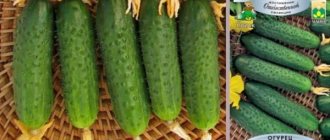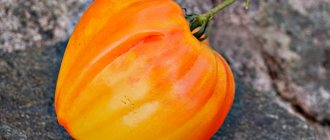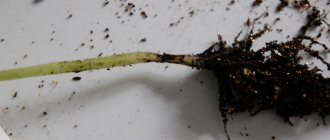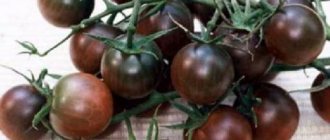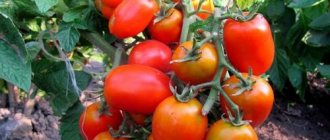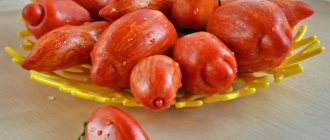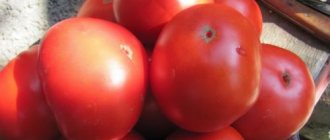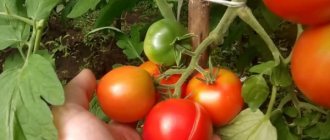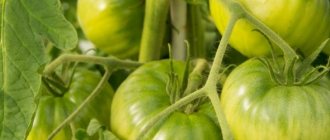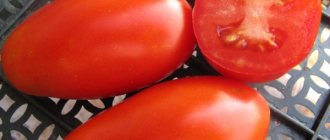The dream of any gardener is a rich harvest combined with excellent taste of the fruit. Therefore, gardeners often plant several crops in order to find among the many the one that will satisfy them in all respects. The task of modern breeding is to combine in one crop all the wishes of gardeners, namely: high fruiting rates, disease resistance and excellent taste.
The Maryina Roshcha tomato is one of these developments from. This hybrid fulfills all the dreams of a gardener. Numerous vegetables surprise even the most experienced vegetable grower with their excellent taste and yield.
Characteristics and description
Hybrid f1 is obtained by crossing two varieties. One indicates belonging to the first generation. As a rule, the main differences between a hybrid and a pure variety are early ripening and high resistance to diseases.
Reference. Translated from Latin, hybrida means “crossbreed”, and f hides the full name filli, which means “child”. It follows that f1 is a child of the first generation.
Distinctive features
The type is indeterminate with a main stem height of 1.5-1.7 m. The stem is powerful with a large number of fruitful branches. Each cluster bears 8-9 fruits. The leaves are medium, dark green.
The ripening period is early, from the moment the seeds are grown to full ripening, 85-100 days pass. The hybrid is intended for cultivation in greenhouse conditions in all regions.
The productivity is high, 5 kg of fruits are collected from 1 seedling when the plants are formed into 1 or 2 stems. A large number of lateral shoots require regular pinching throughout the growing season.
The variety is characterized by good resistance to many diseases of the nightshade family.
When breeding indeterminate plants, do not forget about pinching the crown and installing supports for the garter.
Fruit characteristics
The average weight of one fruit is 160 g, the shape is round, slightly flattened on top. The color is bright red, the taste is sweet with barely noticeable sourness. The pulp is juicy and dense. The peel is thin, but not soft.
The purpose of ripe vegetables is universal; they are used for preparing various fresh dishes, preserves, pickles and marinades. Vegetables are also processed into tomato products, resulting in delicious juices, pastes, sauces and adjika.
Ripe vegetables can withstand long-term transportation and long-term storage. For these reasons, entrepreneurs are considering the variety for commercial purposes.
The photo shows tomatoes Maryina Roshcha f1.
Description of the variety Maryina Roshcha
This species is considered a 1st generation hybrid. This means that the fruits are the same, but the seeds cannot be collected from them. The type of plant is indeterminate, that is, throughout the entire growing season, stem growth does not stop. However, to understand all the features of the Maryina Roshcha tomato, you should familiarize yourself with the characteristics and description of the variety.
The bush grows in height up to 170–180 cm. It has a powerful, strong stem with a large number of lateral branches. To obtain maximum yield, it is recommended to form 2 stems. In this case, the tomato develops many fruit clusters with 7–8 ovaries on each. Due to its tall growth and the presence of a large number of stepsons, the bush needs to be tied to a strong support, as well as regular removal of excess vegetation. The ripening period is 85–100 days from germination to ripening of tomatoes.
The foliage is deep green and medium in size. The foliage shape is typical of a tomato.
As evidenced by reviews from gardeners, Maryina Roshcha tomatoes can withstand lack of lighting and sudden temperature changes, so they can be planted in autumn and winter for growing on a windowsill and as seedlings.
Description of fruits
Vegetables look attractive. On the bush they are arranged in a cluster, tightly adjacent to each other. For the most part, tomatoes are round in shape, only large specimens of the Maryina Roshcha variety may be slightly flattened at the edges. During the ripening process, the color of the tomato changes from light green to bright red. A fully ripe vegetable has a smooth, glossy surface. Due to the smooth, dense skin, the fruits have a marketable appearance and are characterized by high rates of transportability. Tomatoes have a sugary pulp.
On average, the weight of a tomato is 145–175 g. But in some cases, the weight can reach 250 g. Fruit ripening is simultaneous. Judging by the photo, Maryina Roshcha tomatoes hang from the bushes in a cascade.
How to grow seedlings
Sowing seeds for seedlings begins on the twentieth of February. The culture is a hybrid one, so you won’t be able to prepare the seeds yourself. You will have to buy them every time.
Reference. Hybrid seed material is more expensive than pure varietal crops. This is explained by the fact that more time and resources are spent on breeding hybrids.
Seed preparation
Purchased seeds do not require special processing, since the manufacturer takes care of everything himself. But to improve germination, the seeds are soaked in a growth stimulator for 10-11 hours. Specialized drugs (Zircon, Kornevin) or folk remedies (aloe juice and melt water) are used as stimulants.
Reference. When using folk remedies as stimulants, the germination percentage is no lower than when using special preparations.
Selecting a container and preparing the soil
The planting container is a common wooden box or individual containers. Plastic cups are most often chosen from individual containers, as they are the cheapest. Small drainage holes are made at the bottom of the containers to allow excess moisture to drain into them. Waterlogged soil threatens the occurrence of blackleg disease.
Reference. Blackleg is especially dangerous during the seedling period, as it can destroy all seedlings.
The most convenient container for propagating seedlings is peat pots. By selecting these containers, the subsequent expenditure of time and effort is minimized.
When planting in a common wooden box, mandatory picking of seedlings is required, otherwise the root system will not develop properly.
The soil is prepared from turf soil, peat and humus in equal quantities. For additional nutrition, add 1 tablespoon of superphosphate and wood ash. After thoroughly mixing the components, the soil mixture is spilled with a hot solution of potassium permanganate to destroy pathogenic spores. Disinfected soil promotes healthy seedling growth.
The resulting soil is laid out in containers, filling them two-thirds.
Sowing
The seeds are buried 1.5 cm at a distance of 2-3 cm from each other, sprinkled with soil on top, lightly compacted and watered with warm, settled water using a spray bottle.
Important! If the grains are sown shallow, they will germinate along with the shell, which will slow down their further growth.
The sown containers are covered with film to create a greenhouse effect and left in a warm room at a temperature of 24°C until germination.
Seedling care
When shoots appear, the film is removed and the containers are placed in a well-lit place on the windowsill. At least 13 hours of daylight are provided, otherwise, if there is a lack of lighting, the seedlings stretch out and weaken.
The hybrid tolerates lack of lighting, but during the seedling period it is better not to abuse this feature.
Water as the top soil layer dries with warm, settled water. Seedlings need constant moisture feeding; the soil should not be allowed to dry out completely. At the same time, do not over-moisten the soil. This threatens fungal diseases. After watering, the soil is loosened superficially for better oxygen access.
When 2 true leaves appear, the seedlings dive, planting them in separate containers. The seedlings are buried down to the cotyledon leaves. Before picking, the soil is watered generously with warm water in order to replant it together with a lump of earth. Picking promotes increased growth of lateral roots.
2 weeks after picking, the first fertilizing is applied. Dissolve 1 tablespoon of nitrophoska in 1 bucket of water. Fertilizer is applied along with watering.
2 weeks before planting, the seedlings begin to harden. Thanks to this procedure, the seedlings are more likely to take root in the soil and replanting will not be stressful for them.
For hardening, seedlings are taken outside in the daytime for 1 hour, gradually increasing the time spent outside to several hours. Young bushes are hardened at a daytime temperature of at least 16°C. After the stem acquires a light lilac color, the seedlings are ready for transplanting.
Planting and care
At the end of February, tomato seeds are sown for seedlings. The soil is thoroughly fertilized. It is best to take a store-bought substrate, and if you prepare it yourself, then you need to include river sand for drainage, humus and a little superphosphate. Then the soil is shed with a solution of potassium permanganate. The seeds do not need to be disinfected, since they have already been processed, but to increase germination, it is better to briefly soak them in a solution of a growth stimulator.
The depth of the grooves should be about 1-2 cm, and the distance between them should be 2-3 cm. The seeds are sprinkled with earth, carefully watered, the boxes are covered with film and placed in a warm place until germination. When the shoots appear, the containers are moved to a well-lit place and the room temperature is reduced for a week so that the shoots do not stretch. When the seedlings have 2 leaves, they are picked. The size of the pots for picking must be at least 10x10 cm. After the procedure, the daytime air temperature is kept at +22, and the night temperature at +16 degrees.
Ornamental plants - 140 photo options. Review of the most popular plants with names and descriptions. Gardener's recommendations + reviews
2 weeks after picking, feed the bushes. The optimal preparation is nitrophoska, which is diluted in water in a proportion of 1 tbsp. l. for 10 l.
They are transferred to the greenhouse in early May or late April. A week before, you need to treat the soil with preparations containing sulfur. For 1 sq. m. 3 bushes are placed. They are planted in a checkerboard pattern, maintaining a distance of at least 70 cm. A liter of ash, a liter of compost and 2 tbsp. are first placed in each hole. l. superphosphate. Immediately after planting, pour at least 5 liters of water under each bush and mulch the soil.
Subsequently, they water the roots with warm water twice a week, loosen the soil, weed the weeds, carry out disease prevention and form bushes.
How to grow tomatoes
Since tomatoes are planted in a greenhouse, it should be prepared 2 weeks in advance. The soil is dug up and watered with warm water with manganese crystals so that it warms up better. Cold soil will slow down the growth of seedlings. The greenhouse is treated with Bordeaux mixture to kill fungal spores.
Landing
Maryina Roshcha tomatoes should be planted as soon as the soil warms up to 17°C. In pre-prepared holes 15 cm deep, a little wood ash is placed at the bottom, mixed with soil and filled with warm water.
Planting pattern: 40 cm – distance between seedlings, 70 cm – between rows. For 1 sq. m place no more than 3 plants.
After transplantation, the holes are compacted and left to adapt to new conditions for 1 week.
Further care
Water the crop no more than 2 times a week with warm water. It is impossible to flood the beds, as high humidity will provoke the development of fungal diseases. The greenhouse must be ventilated daily. The flow of fresh air is a good prevention of diseases and pests.
After watering, the soil is loosened and hilled, thereby improving the air permeability of the soil. To keep the beds moist longer, they are mulched with straw.
It is necessary to feed the crop once every 10 days. A full complex of minerals or organic matter is used as fertilizer. Fertilizers are mainly used containing phosphorus and calcium. If you feed only nitrogen substances, the plants will gain green mass and not form ovaries. From organic matter, mullein infusion is used in a ratio of 1:10. Mineral fertilizers alternate with organic matter, providing the necessary nutrition throughout the season.
Important! All fertilizing is combined with watering.
Possible difficulties during the growing season
The bush is pruned after the appearance of 8 leaves. Stepchildren are plucked off every week, not allowing them to reach 5 cm. Otherwise, pruning will become a painful procedure for the plants. To avoid infections, the cut sites are treated with a weak solution of manganese.
To increase productivity, plants are formed into 1 or 2 stems. It is with this technique that the maximum indicator can be achieved.
They tie the bushes onto a trellis, installing metal supports on different sides of the bed. A wire is stretched horizontally between the supports and the stem and fruit-bearing branches are fixed to it. Tomatoes are tied regularly as new branches develop.
To limit growth, pinch the top of the head. Without this procedure, the growth of the main stem will not stop, and unnecessary branches will take away the useful substances necessary for the formation of ovaries.
Diseases and pests
Judging by the characteristics and reviews, the Maryina Roshcha hybrid has high immunity, so there is no need to be afraid of fungal and viral infections. If preventative measures are taken, the bushes will remain healthy all season. Prevention consists of following the rules of crop rotation, moderate watering, loosening and daily ventilation of closed structures.
Slugs are especially dangerous among crop pests. Regular inspection of seedlings for the presence of pests will help prevent their spread and take the necessary measures in a timely manner. To combat them, seedlings are regularly sprayed with nettle infusions and the stems are treated with a soap solution. Also, experienced gardeners know that slugs are attracted by the smell of beer, and they set traps by pouring a little beer into them.
Features of transplantation
The optimal time for transplanting tomatoes into a greenhouse is the second half of May.
10 days before the procedure, tomatoes need to be accustomed to the sun and outside temperature. To do this, they are taken outside every day in the morning and kept for 1-2 hours.
Every day, the time spent outside the home is increased by 1 hour. During the last 24 hours, they are left to spend the night on the street under a film cover.
Preparing the site
The best predecessors of tomatoes are peas, vetch, cabbage of all varieties, beets, onions, garlic and cucumbers.
The bed is prepared in advance; it is advisable to carry out all procedures for its preparation in the fall. All weeds and remaining vegetation are removed from the garden and sprinkled with organic and mineral fertilizers.
For 1 m² you will need 10 kg of last year's manure (leaf compost), 3 kg of wood ash, 80 g of potassium salt and 100 g of superphosphate.
If the soil is acidified, add an additional 400 g of chalk or slaked lime. To increase moisture and breathability, add a bucket of peat and sand (sawdust). After this, the area is dug up without breaking up the lumps.
2 weeks before transplanting, loosen the bed, water it with a solution of carbamide (urea) - 15 g dissolved in 10 liters of water. This fertilizer destroys all larvae and pathogens in the soil, and also increases the nitrogen content, which has a beneficial effect on plant growth.
Disembarkation scheme
Bushes need to be planted at a distance of 40-45 cm, keeping a distance between rows of 60 cm. This way they can fully develop and will not be damaged by various diseases and parasites.
The depth of the holes should be the size of the root system. Each is spilled with water, a wooden peg about 1.5 m high is placed nearby. Then the roots are lowered, sprinkled with soil and hilled up to ensure stability and protection from drying out.
Nuances when growing greenhouse plants
The formation of the bush takes place throughout the entire growing season. Lateral shoots appear and grow quickly, and it is important to have time to remove them at a certain length. When they outgrow more than 4-5 cm, after removing the stepsons, the bushes do not resume growth for a long time.
is tied along its entire length, as are the branches with fruits. This is another nuance in the correct formation of the plant. An untimely fixed stem grows uneven and weak, and the branches break, unable to withstand the weight of ripe vegetables.
In addition to removing stepsons , pruning of leaves is necessary to prevent the plantings from becoming dense. Multiple green masses will become a serious obstacle to obtaining the required amount of light and ventilation. All the lower leaves up to the first fruiting cluster are removed so that they do not come into contact with the wet beds.
For preventive purposes, hybrid seedlings are treated with Bordeaux mixture before transplanting into the ground. This not only reduces the risk of fungus, but also helps strengthen the immunity of young plants.
Features of cultivation and storage
The hybrid should be planted in high greenhouses. It is led into 1-2 stems, cutting off the remaining stepsons, and tied to a support, preferably a vertical trellis.
At the beginning of August or after the development of the eighth cluster, the top of the bush is pinched so that the plant spends energy on ripening tomatoes, and not on growing leaves.
It is recommended to carefully pick off the leaves under the fruit clusters as soon as the ovaries begin to develop. Then the fruits will receive more nutrients.
The hybrid is resistant to low light and temperature changes.
The fruits can be stored for quite a long time, they do not wrinkle, do not spoil and are easily transported.
Harvesting and application
The early-ripening hybrid allows you to harvest ripe vegetables from the beginning of July. Fruit ripening is uniform, which makes harvesting easier.
The purpose of tomatoes is universal. They are used not only for preparing a variety of fresh dishes, but also for winter preparations: preserves, marinades and barrel pickles. After processing, tomatoes are used to produce excellent juices, pastes, ketchups, sauces and adjika. Vegetables retain a barely noticeable sourness in any dish, giving them a piquant taste.
Thanks to their strong skin, ripe tomatoes do not lose their presentation for a long time.
Brief information about the variety
- Bush : indeterminate, tall (up to 2 m), needs pinching and staking.
- Fruits : round in shape, with a dense surface of bright red color. Average weight from 150 to 200 g.
- Productivity : up to 15 kg from a bed of 1 m², about 5 kg from one bush.
- Resistance : high resistance against cladosporiosis, late blight, fusarium. Cold resistance is good.
- Distribution : Suitable for greenhouses in risky farming areas. It can be grown in the south in open ground.
- Application : the harvest of this variety is more suitable for processing than for fresh consumption, because the fruits are very dense and not as juicy as those of other hybrid forms. Juices, sauces, pastes are prepared from them, and sometimes added to salads and snacks. Medium-sized tomatoes are suitable for canning whole or in pieces.
- Planting : seeds for seedlings in the first or second half of March. Scheme 3X5 cm.
- Soil : light, loose, well-drained, enriched with organic matter and minerals.
- Care : fertilizing, tying and pinching, watering, loosening, weeding.
- Fruiting period : 100-105 days from the appearance of the first cotyledons. It starts in August and lasts until frost.
Advantages and disadvantages
When breeding hybrid crops, breeders try to take into account all possible disadvantages, due to which the variety has many positive qualities:
- high fruiting rate;
- stable immunity to diseases;
- early ripening;
- simple agricultural technology;
- excellent taste of fruits;
- amicable maturation;
- long-term storage;
- long transportation;
- versatility in cooking.
Negative qualities include:
- mandatory garter throughout the growing season;
- regular stepsoning;
- impossibility of independently collecting seeds.
Advantages and disadvantages
The characteristics of the hybrid are attractive to many gardeners, especially in risky farming zones, since the tomato has all the necessary qualities to obtain a good harvest in this part.
Main advantages:
- high resistance against cladosporiosis, late blight, fusarium;
- good yield and smooth ripening of fruits;
- excellent taste and commercial quality;
- transportability;
- long shelf life - about 2 months;
- early ripeness;
- cold resistance;
- versatility of application.
The variety requires mandatory garter
Disadvantages include: unlimited growth, the need for support and stepsoning. Tomatoes take up a lot of space on the plot, so they are not suitable for growing in small areas.
():
Indeterminate tomatoes take up a lot of space in height, and in terms of soil surface area, in some cases they take up even less space than determinate ones.
Farmer reviews
Reviews with photos indicate the possibility of growing the crop in open ground in the southern regions. But only experienced gardeners can do this, since the hybrid requires a little more attention than in a greenhouse.
Antonina, Anapa: “I am breeding the Maryina Roshcha hybrid in open beds, since the weather conditions are quite conducive to this. I regularly groom my stepson, constantly tie him up, often feed him, in short, I don’t sit idle. I can say with confidence that there are less demanding hybrids, but I really like the taste of my tomatoes. That’s why I’ll plant them again.”
Alla, Voronezh: “Three years ago I saw photographs that impressed me. An unusual red cascade of fruits against a background of green foliage. I plant it in a greenhouse for three seasons. I like everything: it grows quickly, bears fruit well, I have never noticed any diseases on the bush. We constantly eat tomatoes in fresh salads. I really like it canned.”
Secrets of agricultural technology
Maryina Roshcha tomatoes are a hybrid, so they are grown through seedlings. Seeds are sown on February 15 or 20.
Sowing seeds
Sowing containers and soil are treated with boiling water. You can add potassium permanganate to definitely get rid of the black leg. You can prepare the soil yourself or buy ready-made soil.
Composition of soil (bucket) for sowing tomato seeds:
- humus, peat, turf soil in equal proportions;
- wood ash (1 tablespoon), potassium sulfate and superphosphate, one teaspoon each.
As for the preparation of tomato seeds, they are not soaked, but are immediately sown in prepared, well-moistened soil in furrows in increments of 5 to 8 cm, planting depth is 1.5 cm. The furrows are covered with soil and patted down for better adhesion of the seeds to the soil . Before germination, planting containers should be kept in the light in a warm place.
Advice! To speed up seed germination, cover the container with plastic wrap. You only need to water the soil if the surface is dry.
Picking
When the first “hook” appears, the film is removed, if necessary, water the tomato seedlings with warm water and move the boxes to a cooler place so that the sprouts do not stretch.
When the Maryina Roshcha tomato has two true leaves (not cotyledons), they need to be planted. Seedlings are watered to make it convenient to remove the plants and not damage the root system.
Pots for tomatoes should be 8x8 in size. They are filled with fertile soil and watered with a pink solution of potassium permanganate. Tomato seedlings are planted in moist soil. Seedlings with the slightest hint of disease are thrown away.
Comment! If the tomato seedlings have stretched out, they can be deepened, but the cotyledon leaves should remain on top.
After transplanting, for three days you need to maintain a certain temperature for tomato seedlings: during the day +20-22, at night - +16-18. After the seedlings take root, the temperature is reduced by 2 degrees. Water the tomatoes once a week until the soil in the container is completely wet.
Important! The soil should not be allowed to dry out.
After 20 days, the tomato seedlings are again transplanted into large containers. There is no need to bury them. The seedlings are watered and placed in a shaded place for two days so that the tomatoes do not wilt.
Feeding
The tall tomato Maryina Roshcha requires feeding already at the seedling stage:
- The first time tomatoes need nutrition is 14 days after picking. One tablespoon of nitrophoska is diluted in ten liters of water. A glass of fertilizer is poured into each container.
- The next feeding is carried out 14 days after re-transplantation. Wood ash (2 large spoons) and superphosphate (1 large spoon) are dissolved in 10 liters of water. Feeding consumption – 1 cup per tomato bush.
- The third feeding of seedlings is carried out after another 10 days. For a bucket of water, two tablespoons of nitrophoska. The consumption is the same as in previous cases.
- Feeding tomatoes should be combined with watering.
Already at the seedling stage, Maryina Roshcha tomatoes begin to throw out flower clusters and set the first fruits. The root system is powerful, so watering must be taken responsibly. Otherwise, the flowers and ovaries may fall off, and in the future they will grow small, not the same as in the photo and in the description.
Planting in a permanent place
If this is your first time working with the Maryina Roshcha hybrid, then you should pay attention to the planting features. As follows from the description, tomatoes in most parts of Russia need to be grown in a greenhouse.
Greenhouse preparation
- Firstly, you need to plant tomato seedlings only after the soil has warmed up.
- Secondly, the greenhouse itself must be treated with Bordeaux mixture using a sprayer, without missing a single area of the surface.
- Thirdly, the soil must be fertilized, dug up and well watered with warm water two weeks before planting. You can use boiling water with dissolved crystals of potassium permanganate.
Preparing seedlings
Tomato seedlings cannot be planted directly from the window into the greenhouse; they need to be prepared and adapted to new conditions. The tomatoes are taken outside for a few minutes, then the time is increased. The main thing is that there are no drafts. In addition, the two lower leaves are cut off and the cut is treated with wood ash.
Since seeds for seedlings are planted in February, the tomato already has flower clusters and clusters with fruits by the time it is transplanted into the ground. To prevent them from falling off, five days before replanting, the tomatoes are sprayed with a solution of boric acid (1 gram of the drug per 10 liters of water).
Attention! The stems of well-hardened tomato seedlings turn light lilac.
No more than three tomatoes are planted per square meter. Planted plants are immediately watered and tied to a reliable support. As a preventive measure, seedlings of the Maryina Roshcha hybrid should be treated with Bordeaux mixture before and after planting in the greenhouse.
As for the timing of planting tomatoes in a greenhouse, it is simply impossible to give an exact date. Everything will depend on:
- features of the greenhouse;
- climatic conditions of the region;
- the onset of spring in a particular year.
Advice! If you are not confident in your greenhouse, stretch another layer of film at some distance from the first to create an air gap.
Tomato care
Further work is almost the same for all varieties of tomatoes: watering, loosening, weeding. But Maryina Roshcha also needs additional care. This has already been said in the description:
- Feeding with complex fertilizers throughout the growing season.
- Tying the stem and brushes to the support, removing the leaves.
- Limiting the growth of a tomato after the formation of 8-9 clusters, when the stem grows to the top of the greenhouse.
Tips for shaping tomatoes:
So, we have presented to your attention a description of the variety, its main characteristics and a photo of the Maryina Roshcha tomato variety. The information will be useful not only for beginners, but also for experienced gardeners who have decided to take up a new variety. We wish you success!
